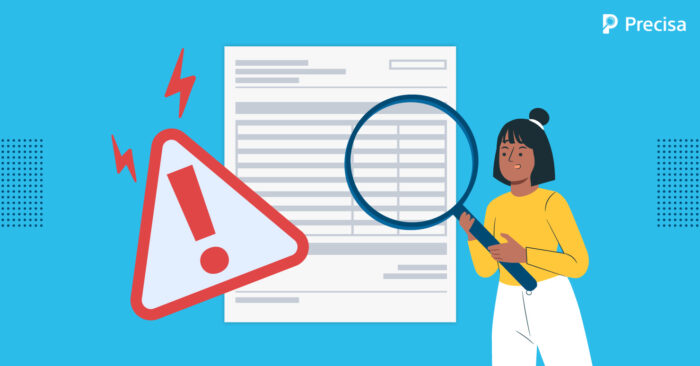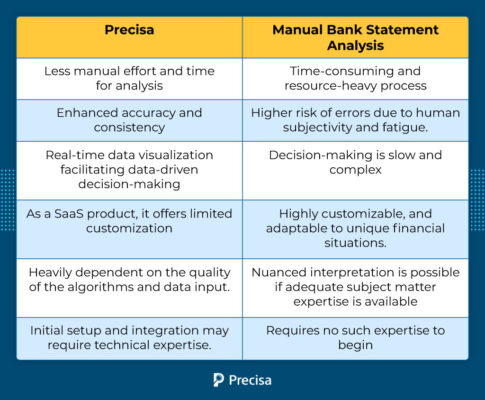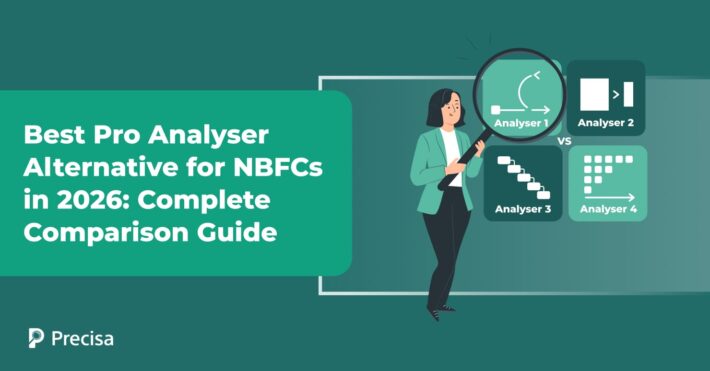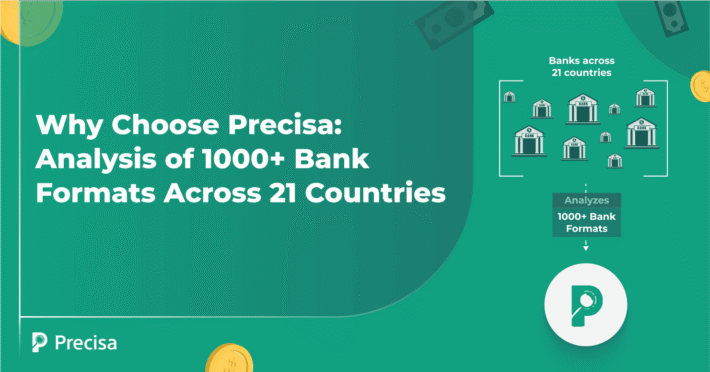Precisa vs Manual Bank Statement Analysis: A Feature Comparison
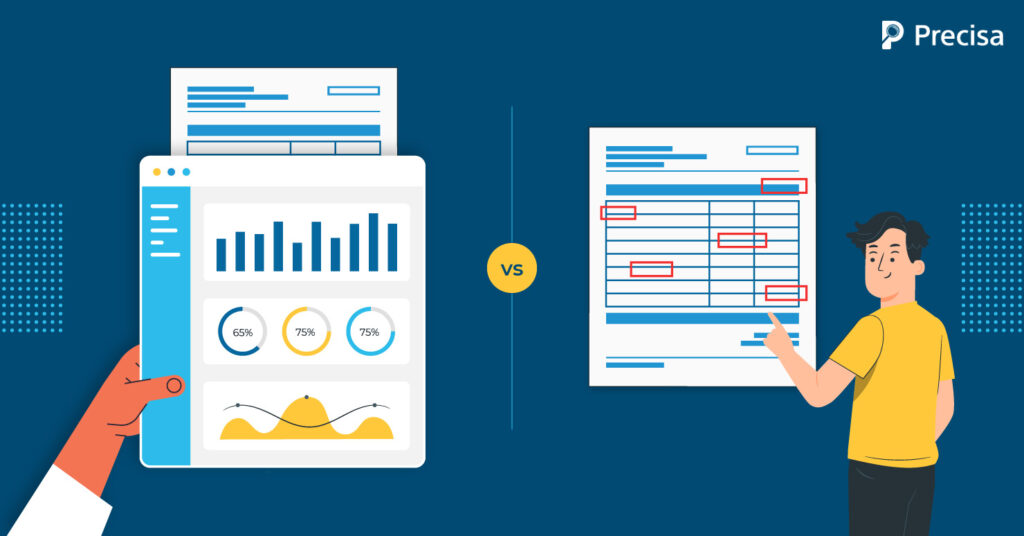
The bank statement analysis process is crucial for individuals, businesses, and financial institutions alike, as it provides insight into financial transactions, cash flow, and other aspects of financial stability.
In spite of offering innumerable benefits, automated bank statement analysis is yet to become the preferred choice for many financial institutions which still prefer manual bank statement processing.
Nevertheless, the global robotic process automation (RPA) market size in the BFSI industry is expected to register a compound annual growth rate (CAGR) of 39.4% from 2023 to 2030, reaching USD 8.79 billion by 2030.
As technology advances, automated tools like Precisa are emerging as compelling alternatives to traditional methods.
In this article, we’ll delve into Precisa, an automated bank statement analysis tool, and compare it with manual analysis, highlighting the distinct features and benefits of each approach.
What is Bank Statement Analysis, and How Does Precisa Help?
Bank statement analysis evaluates customers’ financial transactions, i.e., inflows or credits over time, based on their bank statements. These are valid records of one’s expenses and income and give a fair view of the borrower’s financial health.
It comprises transaction history for a stated period, together with all sources of income, expenditures, EMIs, credit card payments, withdrawals, interest earned, and receipts.
To add, the bank statement analysis software reduces errors caused by manual analyses of bank statements. It automates the processes, thus freeing up the workforce, reducing human efforts, and increasing overall productivity.
For example, Precisa’s bank statement analysis software generates a real-time comprehensive analysis report for the fetched/uploaded bank statements, offering a 360-degree perspective of the customers’ financial health.
Challenges of Manual Bank Statement Analysis
Here is a complete breakdown of the challenges faced by the manual bank statement analysis process:
1. Non- Standardised Data Format
Financial institutions receive bank statement analysis reports in diverse raw formats such as PDF, CSV, Excel, scanned images, email, etc. Extracting and converting this data into a structured, consistent format aligned with the specific requirements makes manual bank statement analysis time-consuming.
2. Human Error
Despite best efforts, manual bank statement analysis is also prone to human errors. Examples include data entry errors or wrong calculations, resulting in inaccurate financial information.
3. Time-Consuming
Manual bank statement analysis can be time-consuming, especially for large institutions with voluminous transactions. It can take days or weeks to complete the analysis, delaying financial reporting and decision-making. This further leads to delays in offering financial help to prospective borrowers/customers.
4. Lack of Data Insights
Manual bank statement analysis may not have the same insights and data visualisation level. This limits the financial institutions’ ability to analyse income/spending patterns to give grading/ scoring as per the bank statement and offer on-time financial help to its customers.
5. Security Risks
Manual bank statement analysis can pose security risks, specifically if multiple people handle sensitive financial information. This can increase the risk of data breaches, fraud, and other security occurrences.
Why the Automated Bank Statement Analysis of Precisa Outperforms Manual Methods?
Precisa’s automated bank statement analysis systematically evaluates statements, identifies fraud, and allocates a Precisa score for accurate creditworthiness assessment. Additionally, embracing automated analysis saves time and helps you make informed decisions.
Some of the features of Precisa that make it more effective and efficient than manual bank statement analysis are as follows.
1. Flawless Detection
Unlike manual processing, Precisa automatically extracts bank and account attributes within seconds of the statement being uploaded. It does so with an accuracy rate of 80% and more than 90% of bank information.
It also speedily generates a report with the account number, account type, bank’s branch, IFSC, and transaction details for verification and analysis.
2. Account Aggregator
Precisa comes ready to be plugged into the account aggregator framework. It facilitates financial institutions to obtain and analyse consolidated financial data from customers’ bank accounts. The link with account aggregator platforms allows the customers’ financial status to be assessed securely.
3. Precisa Score
Precisa comes with numerous in-built security checks and provides prospective borrowers with a loan repayment probability score referred to as Precisa Score.
Precisa assists in tracking a prospective borrower’s credit history and previous payment status. It can track missed payments, payments made, and other significant information that helps ensure payments were made on time. Based on these factors, Precisa assigns scores to prospective borrowers
4. Risk Reduction and Categorisation
Precisa allows tabular data extracted from PDF formats that can be scanned easily. Parsing information from a PDF can be a difficult task and is often complicated. Precisa’s automated bank statement analysis reduces the risk of overlooking errors.
Moreover, categorising and interpreting transaction history become challenging since financial institutions do not follow a standard format to narrate transaction history. Precisa supports different Indian and international banks and their formats.
It also detects the transaction formats of all bank accounts and accurately filters transactions in different categories. This results in comprehensive assessment and analysis.
5. Application Program Interfacing (API)
Precisa has an extensive Application Programming Interface (API). It is simple to integrate into any existing application and deliver the best results via secure data transmission.
The API guarantees a robust, speedy and hassle-free solution. Furthermore, its scalable interface permits advanced credit analytics and effortless end-to-end financial operations management.
6. Predictive Analysis
Precisa can aggregate data from multiple account statements and conduct an exhaustive predictive analysis based on well-defined rules. It has real-time integration with GST and credit bureaus to retrieve up-to-date information on a borrower’s credit history.
These features play a pivotal role in evaluating a borrower’s creditworthiness. Precisa’s bank statement analysis meticulously parses the borrowers’ bank statements and highlights all the essential information to make an informed decision. This is vital for financial institutions to grant loans and reduce non-performing assets (NPAs).
7. Counterparty Tab
Precisa automatically extracts the other party (also known as counterparty) involved in each transaction. The monthly Counterparty tab offers a view of monthly receipts/payments to each counterparty.
This data helps lending institutions quickly identify the top recurring revenue/ expense contributors across all Bank Accounts.
8. E-Statement Authentication
Precisa uses several formats and data checks on PDF bank statements to detect tampering with the e-statements and identify any possible fraudulent activities. The checks help validate the uploaded bank statement by flagging any unexpected behaviour or discrepancies and computing an authenticity rating.
Precisa uses a Penny Drop (depositing INR 1 into a customer’s bank account) to verify the genuineness of the beneficiary’s e-statement. This feature of Precisa assists customers know if their statements have been altered or tampered with.
Comparison Table Between Precisa and Manual Bank Statement Analysis
Final Note
Vis-a-vis manual processes, automated bank statement analysis offers an extraordinary speed of response, removing the necessity for human labour and guaranteeing error-free analysis.
Precisa’s automated bank statement analysis benefits all financial institutions as it enables swift lending decisions, real-time monitoring, and enhanced risk management.
Precisa also has customised pricing models since different users have different requirements, thus offering plan customisation based on requirements.
Book a free trial to learn more about Precisa!

